The Implications of Cloud Adoption on APM

The adoption of cloud computing has significant implications for Application Portfolio Management (APM), impacting various aspects of application governance, management, optimization, and performance monitoring. Here are some key implications of cloud adoption on APM:
Dynamic Infrastructure: Cloud computing enables dynamic provisioning and scaling of infrastructure resources, leading to changes in application architecture, deployment models, and resource utilization patterns. APM needs to adapt to the dynamic nature of cloud infrastructure by providing real-time monitoring, auto-discovery, and resource optimization capabilities to ensure optimal performance and cost-efficiency.
Shift in Governance Models: Cloud adoption requires organizations to rethink their governance models for application management and security. APM must incorporate cloud-specific governance practices, such as cloud security, compliance management, data protection, and service-level agreements (SLAs), to ensure that cloud-based applications adhere to organizational policies and standards.
Elasticity and Scalability: Cloud computing offers elasticity and scalability, allowing organizations to scale applications up or down based on demand. APM needs to support dynamic scaling by providing visibility into resource usage, performance metrics, and cost implications of scaling operations. It should enable organizations to monitor and optimize application performance and costs in response to changing workload requirements.
Cost Management: Cloud adoption introduces new cost considerations, including pay-as-you-go pricing models, resource usage-based billing, and variable costs associated with cloud services. APM must incorporate cost management capabilities to track, analyze, and optimize cloud costs across the application portfolio. It should enable organizations to identify cost-saving opportunities, optimize resource utilization, and enforce cost controls to prevent budget overruns.
Integration Challenges: Cloud adoption often involves integrating cloud-based applications with existing on-premises systems, third-party services, and legacy applications. APM needs to address integration challenges by providing tools and frameworks for seamless integration, data synchronization, and interoperability between cloud and on-premises environments. It should support hybrid integration patterns and ensure that integrations are secure, reliable, and scalable.
Performance Monitoring and Optimization: Cloud adoption requires organizations to monitor application performance across distributed cloud environments and address performance bottlenecks proactively. APM needs to provide comprehensive performance monitoring and optimization capabilities, including real-time monitoring, root cause analysis, and performance tuning for cloud-based applications. It should enable organizations to identify and resolve performance issues quickly to ensure optimal user experience and application availability.
Vendor Management: Cloud adoption involves engaging with cloud service providers (CSPs) and managing vendor relationships effectively. APM needs to support vendor management activities, such as vendor selection, contract negotiation, service-level agreement (SLA) management, and vendor performance evaluation. It should enable organizations to assess the capabilities, reliability, and security of CSPs and ensure that cloud services meet organizational requirements and standards.
Overall, cloud adoption has significant implications for APM, requiring organizations to adapt their APM practices to address the complexities, challenges, and opportunities associated with cloud computing. By incorporating cloud-specific capabilities into APM frameworks, organizations can effectively manage and optimize their application portfolios in the cloud era, driving business agility, innovation, and competitive advantage.
Thank you,